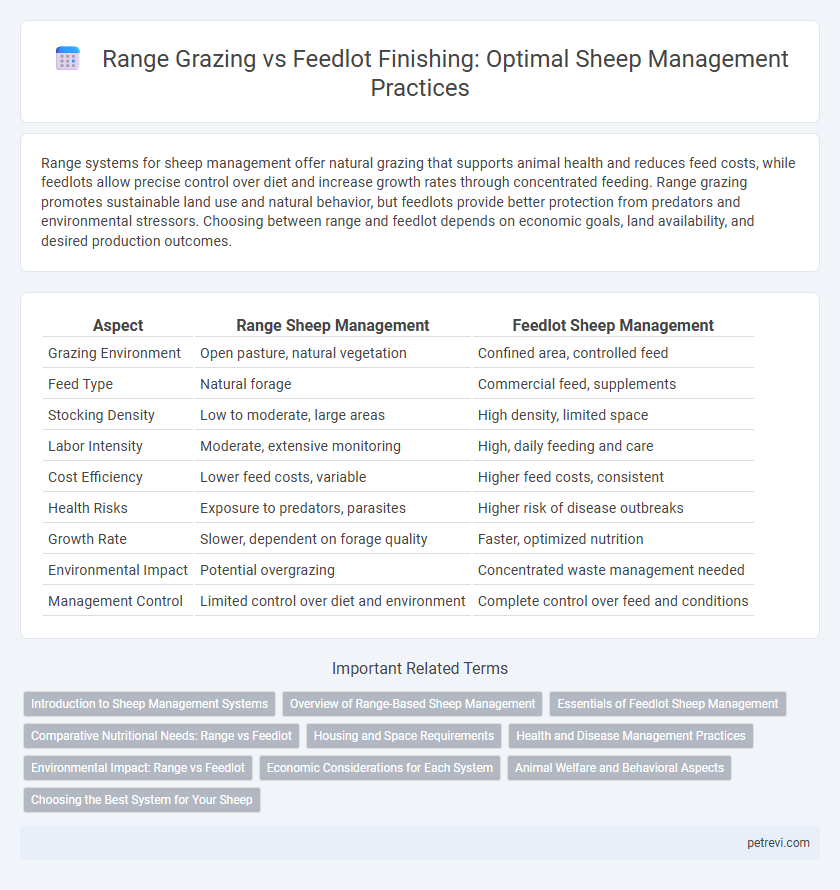Range systems for sheep management offer natural grazing that supports animal health and reduces feed costs, while feedlots allow precise control over diet and increase growth rates through concentrated feeding. Range grazing promotes sustainable land use and natural behavior, but feedlots provide better protection from predators and environmental stressors. Choosing between range and feedlot depends on economic goals, land availability, and desired production outcomes.
Table of Comparison
| Aspect | Range Sheep Management | Feedlot Sheep Management |
|---|---|---|
| Grazing Environment | Open pasture, natural vegetation | Confined area, controlled feed |
| Feed Type | Natural forage | Commercial feed, supplements |
| Stocking Density | Low to moderate, large areas | High density, limited space |
| Labor Intensity | Moderate, extensive monitoring | High, daily feeding and care |
| Cost Efficiency | Lower feed costs, variable | Higher feed costs, consistent |
| Health Risks | Exposure to predators, parasites | Higher risk of disease outbreaks |
| Growth Rate | Slower, dependent on forage quality | Faster, optimized nutrition |
| Environmental Impact | Potential overgrazing | Concentrated waste management needed |
| Management Control | Limited control over diet and environment | Complete control over feed and conditions |
Introduction to Sheep Management Systems
Range sheep management relies on expansive grazing land allowing natural forage consumption, ideal for hardy breeds in arid regions. Feedlot systems concentrate sheep in confined spaces with controlled feeding, optimizing growth rates and meat production for commercial markets. Choosing between range and feedlot depends on factors like climate, land availability, and production goals, influencing overall flock health and profitability.
Overview of Range-Based Sheep Management
Range-based sheep management relies on extensive grazing across large open areas, promoting natural foraging and reducing feed costs by utilizing native vegetation. This method supports animal welfare by allowing sheep to exercise natural behaviors and access diverse forage varieties. Effective range management requires monitoring pasture health, controlling predator risks, and ensuring seasonal forage availability to maintain flock productivity and sustainability.
Essentials of Feedlot Sheep Management
Feedlot sheep management demands precise control of nutrition, housing, and health to maximize growth rates and feed efficiency. Providing a balanced diet rich in energy, protein, and minerals supports optimal weight gain and prevents metabolic disorders common in confined settings. Regular monitoring of flock behavior, disease control measures, and proper ventilation are essential to maintain animal welfare and productivity in a feedlot environment.
Comparative Nutritional Needs: Range vs Feedlot
Sheep managed on range systems primarily consume natural forage, which provides a diverse but variable nutrient profile often low in energy and protein compared to feedlot diets. Feedlot sheep diets are carefully formulated with high-energy grains and protein supplements to meet precise nutritional requirements, supporting faster growth and higher production efficiency. The key nutritional difference lies in energy density and nutrient consistency, with feedlot systems enabling better control over intake and nutrient balance to optimize performance.
Housing and Space Requirements
Range systems require extensive open land allowing sheep to graze naturally, necessitating minimal housing mostly for shelter during extreme weather. Feedlot management demands confined spaces with adequate housing designed for high-density stocking, promoting controlled feeding and health monitoring. Housing in feedlots must ensure proper ventilation, waste management, and space allocation to prevent stress and disease, contrasting the expansive, low-density setup of range systems.
Health and Disease Management Practices
Range-based sheep management promotes natural grazing behaviors, reducing stress and exposure to concentrated pathogens, thereby supporting stronger immune function. Feedlot systems require rigorous biosecurity measures, including regular health monitoring, vaccination protocols, and sanitation, to mitigate the increased risk of disease transmission due to close animal proximity. Integrating rotational grazing and proper ventilation in feedlots can optimize sheep health and minimize outbreaks of common ailments like foot rot and respiratory infections.
Environmental Impact: Range vs Feedlot
Range-based sheep management typically results in lower environmental impact due to natural grazing patterns that promote soil health and biodiversity, reducing the need for supplemental feed and minimizing waste concentration. Feedlot systems, while efficient for weight gain and production, often generate higher levels of concentrated manure and nutrient runoff, leading to soil degradation and water pollution. Sustainable range practices support carbon sequestration and habitat preservation, making them environmentally favorable compared to intensive feedlot operations.
Economic Considerations for Each System
Range sheep management typically offers lower operational costs due to natural grazing, reducing feed expenses and labor requirements, but it may yield slower growth rates and variable wool quality. Feedlot systems require higher initial investment and ongoing feed costs, yet provide controlled nutrition that enhances growth rates, improves feed efficiency, and stabilizes product quality, which can lead to higher market returns. Economic feasibility depends on factors such as land prices, feed availability, market demand, and risk tolerance, with range systems favoring extensive producers and feedlots suiting intensive operations aiming for rapid turnover.
Animal Welfare and Behavioral Aspects
Range-based sheep management supports natural behaviors such as grazing, social interaction, and movement, enhancing overall animal welfare by reducing stress and promoting physical health. Feedlots often restrict space, limiting these behaviors and increasing risks of disease, injuries, and stress-related issues. Well-managed range systems improve welfare outcomes by allowing sheep to express innate behaviors, whereas feedlots require strict monitoring to mitigate negative behavioral impacts.
Choosing the Best System for Your Sheep
Range systems for sheep management offer natural grazing that promotes animal health and reduces feed costs, ideal for operations with ample pastureland. Feedlot systems provide controlled feeding, enabling precise nutrition and faster weight gain, suitable for intensive production and market demands. Selecting the best system depends on land availability, management goals, and economic factors to optimize sheep growth and welfare.
Range vs Feedlot for Sheep Management Infographic

 petrevi.com
petrevi.com